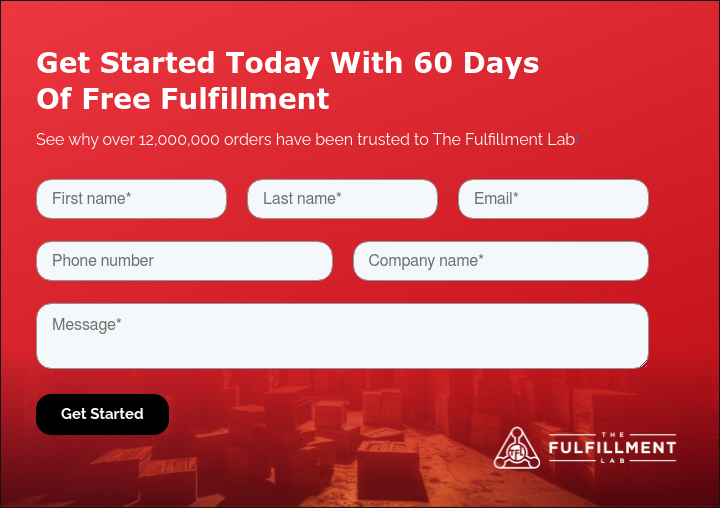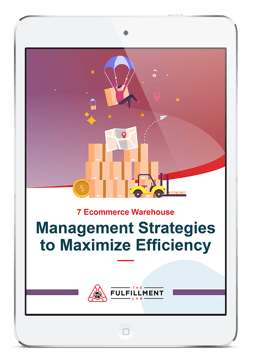8 Types of Warehouse Security Measures
Inventory shrinkage, cargo theft, lost inventory—whatever you call it—the loss or theft of valuable inventory in your warehouse can be a big problem. Theft from warehouses and distribution centers is the number-one source of loss within a supply chain, and that makes robust warehouse security measures more crucial than ever before.
|
“Effective physical security measures cannot be overlooked in a warehouse operation. Securing the contents – and people – within a warehouse is critical for both the warehouse and the companies they serve.” Rick Nelson, CEO, The Fulfillment Lab |
Security solutions for warehouses have evolved. Modern security solutions effective for today’s robust warehousing facilities take advantage of digital security solutions, as well as traditional measures, such as physical guard. Today we’ll explore the best security options warehouses should consider to secure their valuable, high-volume facilities.
The Importance of Warehouse Security
A lack of warehouse security gives thieves an easy way to steal products and make a quick buck—and no retailer who ships goods is immune to theft. If customers are willing to buy the product, then it has a value thieves can capitalize on. That means if you have an online store and rely on warehouses to store your inventory, you’re at risk of theft.
You might be wondering: “What if I’m not managing a warehouse myself? Do I still need to worry about security then?” The answer is yes. If you’re partnering with a third-party logistics (3PL) company, their warehouse/distribution center security is still very much a concern since it affects your products.
If you rely on 3PL fulfillment centers or warehouses, it’s crucial they have the right security measures in place to safeguard your products and inventory.
Warehouse Security System Essentials: Protect the Facility Inside and Out
Perimeter Security
When it comes to warehouse security, it’s important to protect the facility both inside and out. External-facing warehouse security systems, called perimeter security, are used to defend entry points, parking lots, and the property line.
These external security measures are useful for preventing theft by keeping thieves out of the warehouse or by intimidating casual thieves into thinking the theft attempt isn’t worth the effort and risk.
Internal Security
Internal warehouse security measures help to catch thieves who breach external warehouse security or employees who abuse their access to steal products from the warehouse. Instead of prevention and intimidation, internal security measures often focus on limiting access or capturing evidence to help catch thieves after the fact.
The Importance of Layered Security Systems for Warehouses
It’s important to have layered security measures to protect the facility inside and out. After all, as noted by Study.com, in a warehouse: “People are bringing things in and out on a regular basis, and some of those people may not be your employees. There are probably multiple entrances and exits and they might not all be manned 24/7.”
Because of how many entry ways and exits there are in a warehouse, combined with the presence of non-warehouse personnel, it’s all too easy for a thief to infiltrate the warehouse and walk off with valuable goods amid the hustle and bustle. This is why both internal and external warehouse security solutions are necessary.
Secure Productivity With a Better Warehouse Management Strategy!Explore 7 actionable tips today. Download our ebook.
|
8 Types of Warehouse Security Measures
What are some of the specific types of warehouse security measures that are needed to create a high-security warehouse? Some examples of useful warehouse security tools include:
1. Warehouse Security Cameras. Security camera warehouse setups can be both a great deterrent to thieves and a simple way to gather strong evidence to pursue a case against them if they do steal something.
Modern security camera systems can collect high-definition footage and upload it to an offsite server to make identification of thieves easier and preserve the evidence if they try to tamper with the cameras or onsite recording stations.
2. Warehouse Lighting. Yes, lighting can be considered a vital part of warehouse security. Poorly-lit warehouses not only provide protection for thieves (making them harder to identify), they can be a safety hazard for warehouse employees and security staff.
So, keeping warehouse facilities well-lit is a crucial safety measure—both to prevent theft and on-site accidents.
3. Alarm Systems. Alarm systems can be a crucial tool for deterring theft attempts, minimizing the amount of goods stolen by thieves, and summoning security or police in time to stop thieves from getting away.
Knowing that there’s an alarm keeps thieves on a tight time limit so they don’t steal as much (or deter them from the attempt). Getting an alert from a silent alarm helps security and police arrive on the scene quickly so thieves can be detained before they make off with valuable products.
4. Security Patrols. Does the warehouse have on-site security staff to help deter thieves? Do they make the rounds to verify that there are no intruders lurking in security camera blind spots?
Having manual security patrols to police the premises can be a massive deterrent to casual thieves and trespassers that minimizes large-scale theft risks.
5. Access Control Systems and Security Cages. How is high-value merchandise kept secure within the warehouse? How is access to these items controlled? Security cages and access control systems make it harder for thieves to get at valuable inventory—creating a high-security warehouse environment that minimizes theft risks.
6. Inventory Tracking. How is inventory in the warehouse tracked? How frequently is inventory checked for missing products? Inventory tracking solutions are vital for ensuring that inventory shrinkage can be identified quickly (and that inventory availability reports in your ecommerce store are accurate).
Inventory security is a loss prevention 101 basic. Consider RFID tags, or GPS tracking.
|
Other article we think you’ll like: |
7. Entryway Security Doors. How tough are the doors allowing entry into the warehouse to bypass? Weak locks or doors can allow thieves into the warehouse quickly, giving them easy access to the interior.
Robust doorways delay thieves, increasing the likelihood of them getting caught by police/security (and of them giving up before making entry). Access control systems that electronically monitor exactly who is in a facility adds another essential layer of security.
8. Window Security. Are there ground-level windows that thieves can easily break to get into the warehouse?
Or, are they high up and reinforced to prevent break-in and entry? Strong security means making windows as difficult to break into as possible, such as using impact resistant glass block windows, window locking mechanisms, or even steel bars/window covers to deter entry attempts.
These eight items aren’t the only warehouse security tools that you might use to protect your warehouse. While no security will ever be 100% proof against thieves, using all of these measures helps to create a high-security warehouse that minimizes risks and better protects your products.
7 Ways to Improve Warehouse Security
So, how can you improve security in your warehouse as soon as possible? Here are a few suggestions:
1. Upgrade Your Security Measures. Looking at the list from the “Types of Warehouse Security Measures” section, how many of them is your warehouse currently using?
Do you have the budget to upgrade these measures or to add new ones? Taking a look at the security measures list and filling in any significant gaps can go a long way towards improving your facility’s overall security.
2. Use Remote Camera Footage Backups. If you have security cameras, it can be well worth your while to subscribe to a service that backs up your security footage in real time for offsite storage.
This way, if thieves break into the warehouse, they won’t be able to destroy the footage by simply breaking into the security/AV room.
3. Reinforce Entryways. It is easy to focus so much on buying solid steel doors and fancy, high-priced locks, but forget to ensure that the doorframe is just as robust for standard swing-style doors.
Reinforcing door frames, using strong deadbolts, and installing long, high-durability door screws can be just as important as having a tough door. Sources such as ACME Locksmith recommend changing out 1/2 inch door screws for 3 1/2 inch versions since this makes it much harder to kick in a door.
For rolling doors, using high-strength locking mechanisms and thicker-gauge steel can prevent most intrusion attempts. Windows should be reinforced and kept locked whenever the warehouse is not in use. Rolling steel shutters can help further secure windows (and prove useful during hurricane season).
4. Outsource Distribution and Fulfillment to a Proven Partner. Instead of trying to tackle the security for a warehouse (and spending money on warehouse floor space) on your own, you may want to consider outsourcing to a third-party logistics partner.
A 3PL solution helps you meet your order fulfillment needs without you having to worry about specific fulfillment processes, finding the right security solution, and other warehouse management concerns. Instead, you can save time and focus more on developing your business.
5. Make Security Checks a Part of Closing Procedures. If your warehouse/distribution center isn’t operating 24/7, it’s important to have a set process for shutting the facility down at the end of the work day.
Supervisors and/or security should check any security cages and locks to verify that they are secure, patrol the facility to check for open windows/skylights/doors, and ensure that the facility is empty before setting the alarm and leaving.
Or, consider investing in an overnight security team such as physical guards. If you operate multiple facilities, consider investing in remote security guards that can watch all your facilities from a secure, remote control room.
6. Perform Background Checks On All Warehouse Staff. Internal theft is a major source of inventory shrinkage for any business. Before entrusting someone with all of your most valuable products, it’s necessary to verify their trustworthiness.
Background checks on employees are a vital part of the process for vetting new hires—especially if they’re going to be handling small, high-value items frequently. Many businesses use background checks to vet their employees to help manage their risks.
7. Outsource Distribution and Fulfillment to a Proven Partner. Instead of trying to tackle the security for a warehouse (and spending money on warehouse floor space) on your own, you may want to consider outsourcing to a third-party logistics partner.
A 3PL solution helps you meet your order fulfillment needs without you having to worry about specific fulfillment processes, finding the right security solution, and other warehouse management concerns. Instead, you can save time and focus more on developing your business.

Warehouse Security Matters—Partner with a Team You Can Trust
Are you ready to transform your order fulfillment in a way that saves time and money while improving your logistics? At The Fulfillment Lab, we’ve helped ecommerce companies like yours save over $100,000 on shipping costs as well as help them connect better with their customers.
Are you ready to save big and make your customers happier?
Reach out to The Fulfillment Lab today. Let’s get started!




